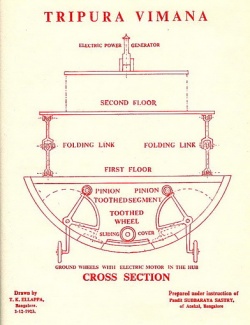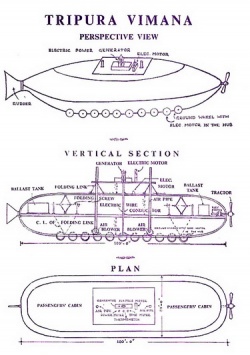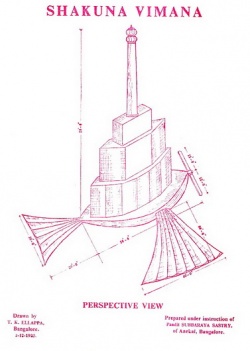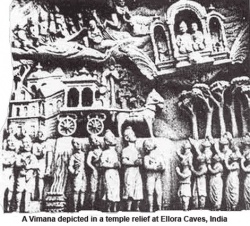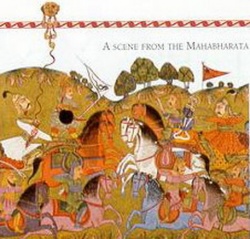Difference between revisions of "Bodhaanada"
(Created page with "thumb|250px| <poem> Scientists say that there are 32 secrets of the working of the Vimana. A pilot should acquaint himself thoroughly with them before h...") |
|||
| Line 1: | Line 1: | ||
[[File:Pl09.jpg|thumb|250px|]] | [[File:Pl09.jpg|thumb|250px|]] | ||
<poem> | <poem> | ||
| − | Scientists say that there are 32 secrets of the working of the Vimana. | + | [[Scientists]] say that there are 32 secrets of the working of the [[Vimana]]. |
| − | A pilot should acquaint himself thoroughly with them before he can be deemed competent to handle the airplane. He must know the structure of the aeroplane, know the means of its take off and ascent to the sky, know how to drive it and how to halt it when necessary, how to maneuver it and make it perform spectacular feats in the sky without crashing. | + | A pilot should acquaint himself thoroughly with them before he can be deemed competent to handle the airplane. He must know the {{Wiki|structure}} of the aeroplane, know the means of its take off and [[ascent]] to the sky, know how to drive it and how to halt it when necessary, how to maneuver it and make it perform spectacular feats in the sky without crashing. |
| − | Those secrets are given in "Rahashya Lahari" and other works by Lalla and other masters, are are described thus: | + | Those secrets are given in "Rahashya Lahari" and other works by Lalla and other [[masters]], are are described thus: |
| − | "The pilot should have had training in maantrica and taantrica, kritaka and antaraalaka, goodha or hidden, drishya and adrishya or seen and unseen, paroksha and aparoksha, contraction and expansion, changing shape, look frightening, look pleasing, become luminous or enveloped in darkness, deluge or pralaya, vimukha, taara, stun by thunderstorm din, jump, move zig-zag like serpent, chaapala, face all sides, hear distant sounds, take pictures, know enemy maneuver, know direction of enemy approach, stabdhaka or paralyze, and karshana or exercise magnetic pull" | + | "The pilot should have had {{Wiki|training}} in maantrica and taantrica, kritaka and antaraalaka, goodha or hidden, drishya and adrishya or seen and unseen, paroksha and aparoksha, contraction and expansion, changing shape, look frightening, look [[pleasing]], become {{Wiki|luminous}} or enveloped in {{Wiki|darkness}}, deluge or [[pralaya]], vimukha, taara, stun by thunderstorm din, jump, move zig-zag like [[serpent]], chaapala, face all sides, hear distant {{Wiki|sounds}}, take pictures, know enemy maneuver, know [[direction]] of enemy approach, stabdhaka or paralyze, and karshana or exercise magnetic pull" |
| − | These 32 secrets the pilot should learn from competent preceptors and only such a person is fit to be entrusted with an airplane, and not others. | + | These 32 secrets the pilot should learn from competent preceptors and only such a [[person]] is fit to be entrusted with an airplane, and not others. |
| Line 19: | Line 19: | ||
Some of these secrets are: | Some of these secrets are: | ||
| − | 12. Tripura Vimana: Perspective and Vertical Section1. Goodha: As explained in 'Vaayutatva-Prakarana', by harnessing the powers, Yaasaa, Viyaasaa, Prayaasaa in the 8th atmospheric layer covering the earth, to attract the dark content of the solar ray, and use it to hide the Vimana from the enemy. | + | 12. [[Tripura]] [[Vimana]]: {{Wiki|Perspective}} and Vertical Section1. Goodha: As explained in 'Vaayutatva-Prakarana', by harnessing the [[powers]], Yaasaa, Viyaasaa, Prayaasaa in the 8th atmospheric layer covering the [[earth]], to attract the dark content of the {{Wiki|solar}} ray, and use it to hide the [[Vimana]] from the enemy. |
| − | 2. Drishya: By collision of the electric power and wind power in the atmosphere, a glow is created, whose reflection is to be caught in the Vishwa-Kriya-drapana or mirror at the front of the Vimana, and by its manipulation produce a Maaya-Vimana or camouflaged Vimana. | + | 2. Drishya: By [[collision]] of the electric power and [[wind]] power in the {{Wiki|atmosphere}}, a glow is created, whose {{Wiki|reflection}} is to be caught in the Vishwa-Kriya-drapana or [[mirror]] at the front of the [[Vimana]], and by its manipulation produce a Maaya-Vimana or camouflaged [[Vimana]]. |
[[File:Pl12.jpg|thumb|250px|]] | [[File:Pl12.jpg|thumb|250px|]] | ||
| − | 3. Vimukha: As mentioned in "Rig-hridaya", by projecting the force of Kubera, Vimukha and Vyshawaanara poison powder through the third tube of the roudree mirror and turning the switch of the air mechanism, produce wholesale insensibility and coma. | + | 3. Vimukha: As mentioned in "Rig-hridaya", by projecting the force of [[Kubera]], Vimukha and Vyshawaanara [[poison]] powder through the third tube of the roudree [[mirror]] and turning the switch of the [[air]] {{Wiki|mechanism}}, produce wholesale insensibility and coma. |
| − | 4. Roopaakarshana: By means of the photographic yantra in the Vimana to obtain a television view of things inside an enemy's plane. | + | 4. Roopaakarshana: By means of the photographic [[yantra]] in the [[Vimana]] to obtain a television view of things inside an enemy's plane. |
| − | 5. Stabdhak: By projecting apasmaara poison fume smoke through the tube on the north side on the Vimana, and discharging it with stambhana yantra, people in enemy planes will be made unconscious. | + | 5. Stabdhak: By projecting apasmaara [[poison]] fume smoke through the tube on the [[north]] side on the [[Vimana]], and discharging it with [[stambhana]] [[yantra]], [[people]] in enemy planes will be made [[unconscious]]. |
| − | 6. Chaapla: On sighting an enemy plane, by turning the switch in the force center in the middle section of the Vimana, a 4087 revolutions an hour atmospheric wave speed will be generated, and shake up the enemy plane. | + | 6. Chaapla: On sighting an enemy plane, by turning the switch in the force center in the middle section of the [[Vimana]], a 4087 revolutions an hour atmospheric wave {{Wiki|speed}} will be generated, and shake up the enemy plane. |
| − | 7. Parashabda Graahaka: As explained in the "Sowdaaminee Kalaa: or science of electronics, by means of the sound capturing yantra in the Vimana, to hear the talks and sound in enemy planes flying in the sky. | + | 7. Parashabda [[Graahaka]]: As explained in the "Sowdaaminee Kalaa: or [[science]] of electronics, by means of the [[sound]] capturing [[yantra]] in the [[Vimana]], to hear the talks and [[sound]] in enemy planes flying in the sky. |
According to Shownaka, the regions of the sky are 5, named, | According to Shownaka, the regions of the sky are 5, named, | ||
| Line 41: | Line 41: | ||
Rekhaapathaha | Rekhaapathaha | ||
| − | Mandala | + | [[Mandala]] |
Kakshaya | Kakshaya | ||
| − | Shakti | + | [[Shakti]] |
| − | Kendra | + | [[Kendra]] |
[[File:Pl13.jpg|thumb|250px|]] | [[File:Pl13.jpg|thumb|250px|]] | ||
| − | In these 5 atmospheric regions, there are 5,19,800 air ways traversed by Vimanas of the Seven Lokas or worlds, known as, | + | In these 5 atmospheric regions, there are 5,19,800 [[air]] ways traversed by [[Vimanas]] of the Seven [[Lokas]] or [[worlds]], known as, |
Bhooloka | Bhooloka | ||
| − | Bhuvarloka | + | [[Bhuvarloka]] |
Suvarloka | Suvarloka | ||
| Line 61: | Line 61: | ||
Janoloka | Janoloka | ||
| − | Tapoloka | + | [[Tapoloka]] |
| − | Satyaloka | + | [[Satyaloka]] |
| − | Dhundinaatha and "Valalmeeki Ganita" state that Rekha has 7,03,00,800 air routes. | + | Dhundinaatha and "Valalmeeki Ganita" state that Rekha has 7,03,00,800 [[air]] routes. |
| − | Mandala has 20,08,00200 air routes | + | [[Mandala]] has 20,08,00200 [[air]] routes |
| − | Kakshya has 2,09,00,300 air routes | + | Kakshya has 2,09,00,300 [[air]] routes |
| − | Shakti has 10,01,300 air routes | + | [[Shakti]] has 10,01,300 [[air]] routes |
| − | Kendra has 30,08,200 air routes | + | [[Kendra]] has 30,08,200 [[air]] routes |
| − | It discusses what kind of food to eat, clothing to wear, metals for vimanas, purification of metals, deals with mirrors and lenses which are required to be installed in the vimanas, mechanical contrivances or yantras and protecting and different types of vimanas. | + | It discusses what kind of [[food]] to eat, clothing to wear, metals for [[vimanas]], [[purification]] of metals, deals with mirrors and lenses which are required to be installed in the [[vimanas]], mechanical contrivances or [[yantras]] and protecting and different types of [[vimanas]]. |
| − | (source: Vymaanika Shaastra Aeronautics of Maharshi Bharadwaaja | + | (source: Vymaanika [[Shaastra]] Aeronautics of Maharshi Bharadwaaja |
[[File:Vimanas_17.JPG|thumb|250px|]] | [[File:Vimanas_17.JPG|thumb|250px|]] | ||
| − | By G. R. Josyer International Academy of Sanskrit Research 1973). | + | By G. R. Josyer International {{Wiki|Academy}} of [[Sanskrit]] Research 1973). |
| Line 91: | Line 91: | ||
| − | A glass-like material based on technology found in an ancient Sanskrit text that could ultimately be used in a stealth bomber (the material cannot be detected by radar) has been developed by a research scholar of Benaras Hindu University. | + | A glass-like material based on technology found in an [[ancient]] [[Sanskrit]] text that could ultimately be used in a stealth bomber (the material cannot be detected by radar) has been developed by a research [[scholar]] of Benaras [[Hindu]] {{Wiki|University}}. |
| − | Prof M A Lakshmithathachar, Director of the Academy of Sanskrit Research in Melkote, near Mandya, told Deccan Herald that tests conducted with the material showed radars could not detect it. “The unique material cannot be traced by radar and so a plane coated with it cannot be detected using radar,” he said. | + | Prof M A Lakshmithathachar, Director of the {{Wiki|Academy}} of [[Sanskrit]] Research in Melkote, near Mandya, told Deccan Herald that tests conducted with the material showed radars could not detect it. “The unique material cannot be traced by radar and so a plane coated with it cannot be detected using radar,” he said. |
[[File:Vimanas_20.jpg|thumb|250px|]] | [[File:Vimanas_20.jpg|thumb|250px|]] | ||
| − | The academy had been commissioned by the Aeronautical Research Development Board, New Delhi, to take up a one-year study, ‘Non-conventional approach to Aeronautics,’ on the basis of an old text, Vaimanika Shastra, authored by Bharadwaj. Though the period to which Bharadwaj belonged to is not very clear, Prof Lakshmithathachar noted, the manuscripts might be more 1,000 years old. The project aims at deciphering the Bharadwaj’s concepts in aviation. | + | The {{Wiki|academy}} had been commissioned by the Aeronautical Research [[Development]] Board, {{Wiki|New Delhi}}, to take up a one-year study, ‘Non-conventional approach to Aeronautics,’ on the basis of an old text, Vaimanika Shastra, authored by Bharadwaj. Though the period to which Bharadwaj belonged to is not very clear, Prof Lakshmithathachar noted, the manuscripts might be more 1,000 years old. The project aims at deciphering the Bharadwaj’s [[Wikipedia:concept|concepts]] in aviation. |
| − | However, Prof Lakshmithathachar was quick to add that a collaborative effort from scholars of Sanskrit, physics, mathematics and aeronautics is needed to understand Bharadwaj’s shastra. | + | However, Prof Lakshmithathachar was quick to add that a collaborative [[effort]] from [[scholars]] of [[Sanskrit]], [[physics]], {{Wiki|mathematics}} and aeronautics is needed to understand Bharadwaj’s shastra. |
| − | The country’s interest in aviation can be traced back over 2,000 years to the mythological era and the epic Ramayana tells of a supersonic-type plane, the Pushpak Vimana, which could fly at the speed of thought. | + | The country’s [[interest]] in aviation can be traced back over 2,000 years to the [[mythological]] {{Wiki|era}} and the {{Wiki|epic}} [[Ramayana]] tells of a supersonic-type plane, the Pushpak [[Vimana]], which could fly at the {{Wiki|speed}} of [[thought]]. |
| − | “The shastra has interesting information on vimanas (airplanes), different types of metals and alloys, a spectrometer and even flying gear,” the professor said. | + | “The shastra has [[interesting]] [[information]] on [[vimanas]] (airplanes), different types of metals and alloys, a spectrometer and even flying gear,” the {{Wiki|professor}} said. |
| − | The shastra also outlines the metallurgical method to prepare an alloy very light and strong which could withstand high pressure. | + | The shastra also outlines the metallurgical method to prepare an alloy very {{Wiki|light}} and strong which could withstand high pressure. |
| − | He said, Prof Dongre of BHU had brought out a research paper Amshubondhini after studying Vaimanika Shastra and developed the material. “There have been sporadic efforts to develop aeronautics in the country’s history. There has never been a holistic approach to it. Vaimanika Shastra throws up many interesting details that can benefit Indian aviation program,” the director added. | + | He said, Prof Dongre of BHU had brought out a research paper Amshubondhini after studying Vaimanika Shastra and developed the material. “There have been sporadic efforts to develop aeronautics in the country’s history. There has never been a {{Wiki|holistic}} approach to it. Vaimanika Shastra throws up many [[interesting]] details that can [[benefit]] [[Indian]] aviation program,” the director added. |
| − | Prof Lakshmithathachar rubbished the tendency among certain scholars to discount such ancient Sanskrit texts and said, | + | Prof Lakshmithathachar rubbished the tendency among certain [[scholars]] to discount such [[ancient]] [[Sanskrit]] texts and said, |
| − | “Why would our scholars want to cheat future generations? Unless it was important, nothing was written in the old days. The fact that there exists manuscripts indicates the significance.” | + | “Why would our [[scholars]] want to cheat {{Wiki|future}} generations? Unless it was important, nothing was written in the old days. The fact that there [[exists]] manuscripts indicates the significance.” |
| − | The academy has also embarked on other projects including | + | The {{Wiki|academy}} has also embarked on other projects including ‘[[Indian]] {{Wiki|concept}} of [[Cosmology]]’ with [[Indian]] [[Space]] Research Organization, ‘{{Wiki|Iron}} & Steel in {{Wiki|Ancient India}} - A Historical {{Wiki|Perspective}}’ with the Steel Authority of [[India]] Limited, and ‘Tools & {{Wiki|Technology}} of {{Wiki|Ancient India}}.’ |
(source: Stealth bomber from shastra - deccan herald November 2, 02) | (source: Stealth bomber from shastra - deccan herald November 2, 02) | ||
Latest revision as of 09:55, 7 January 2015
Scientists say that there are 32 secrets of the working of the Vimana.
A pilot should acquaint himself thoroughly with them before he can be deemed competent to handle the airplane. He must know the structure of the aeroplane, know the means of its take off and ascent to the sky, know how to drive it and how to halt it when necessary, how to maneuver it and make it perform spectacular feats in the sky without crashing.
Those secrets are given in "Rahashya Lahari" and other works by Lalla and other masters, are are described thus:
"The pilot should have had training in maantrica and taantrica, kritaka and antaraalaka, goodha or hidden, drishya and adrishya or seen and unseen, paroksha and aparoksha, contraction and expansion, changing shape, look frightening, look pleasing, become luminous or enveloped in darkness, deluge or pralaya, vimukha, taara, stun by thunderstorm din, jump, move zig-zag like serpent, chaapala, face all sides, hear distant sounds, take pictures, know enemy maneuver, know direction of enemy approach, stabdhaka or paralyze, and karshana or exercise magnetic pull"
These 32 secrets the pilot should learn from competent preceptors and only such a person is fit to be entrusted with an airplane, and not others.
Some of these secrets are:
12. Tripura Vimana: Perspective and Vertical Section1. Goodha: As explained in 'Vaayutatva-Prakarana', by harnessing the powers, Yaasaa, Viyaasaa, Prayaasaa in the 8th atmospheric layer covering the earth, to attract the dark content of the solar ray, and use it to hide the Vimana from the enemy.
2. Drishya: By collision of the electric power and wind power in the atmosphere, a glow is created, whose reflection is to be caught in the Vishwa-Kriya-drapana or mirror at the front of the Vimana, and by its manipulation produce a Maaya-Vimana or camouflaged Vimana.
3. Vimukha: As mentioned in "Rig-hridaya", by projecting the force of Kubera, Vimukha and Vyshawaanara poison powder through the third tube of the roudree mirror and turning the switch of the air mechanism, produce wholesale insensibility and coma.
4. Roopaakarshana: By means of the photographic yantra in the Vimana to obtain a television view of things inside an enemy's plane.
5. Stabdhak: By projecting apasmaara poison fume smoke through the tube on the north side on the Vimana, and discharging it with stambhana yantra, people in enemy planes will be made unconscious.
6. Chaapla: On sighting an enemy plane, by turning the switch in the force center in the middle section of the Vimana, a 4087 revolutions an hour atmospheric wave speed will be generated, and shake up the enemy plane.
7. Parashabda Graahaka: As explained in the "Sowdaaminee Kalaa: or science of electronics, by means of the sound capturing yantra in the Vimana, to hear the talks and sound in enemy planes flying in the sky.
According to Shownaka, the regions of the sky are 5, named,
Rekhaapathaha
Mandala
Kakshaya
Shakti
Kendra
In these 5 atmospheric regions, there are 5,19,800 air ways traversed by Vimanas of the Seven Lokas or worlds, known as,
Bhooloka
Bhuvarloka
Suvarloka
Maholoka
Janoloka
Tapoloka
Satyaloka
Dhundinaatha and "Valalmeeki Ganita" state that Rekha has 7,03,00,800 air routes.
Mandala has 20,08,00200 air routes
Kakshya has 2,09,00,300 air routes
Shakti has 10,01,300 air routes
Kendra has 30,08,200 air routes
It discusses what kind of food to eat, clothing to wear, metals for vimanas, purification of metals, deals with mirrors and lenses which are required to be installed in the vimanas, mechanical contrivances or yantras and protecting and different types of vimanas.
(source: Vymaanika Shaastra Aeronautics of Maharshi Bharadwaaja
By G. R. Josyer International Academy of Sanskrit Research 1973).
Stealth bomber from Shastra
A glass-like material based on technology found in an ancient Sanskrit text that could ultimately be used in a stealth bomber (the material cannot be detected by radar) has been developed by a research scholar of Benaras Hindu University.
Prof M A Lakshmithathachar, Director of the Academy of Sanskrit Research in Melkote, near Mandya, told Deccan Herald that tests conducted with the material showed radars could not detect it. “The unique material cannot be traced by radar and so a plane coated with it cannot be detected using radar,” he said.
The academy had been commissioned by the Aeronautical Research Development Board, New Delhi, to take up a one-year study, ‘Non-conventional approach to Aeronautics,’ on the basis of an old text, Vaimanika Shastra, authored by Bharadwaj. Though the period to which Bharadwaj belonged to is not very clear, Prof Lakshmithathachar noted, the manuscripts might be more 1,000 years old. The project aims at deciphering the Bharadwaj’s concepts in aviation.
However, Prof Lakshmithathachar was quick to add that a collaborative effort from scholars of Sanskrit, physics, mathematics and aeronautics is needed to understand Bharadwaj’s shastra.
The country’s interest in aviation can be traced back over 2,000 years to the mythological era and the epic Ramayana tells of a supersonic-type plane, the Pushpak Vimana, which could fly at the speed of thought.
“The shastra has interesting information on vimanas (airplanes), different types of metals and alloys, a spectrometer and even flying gear,” the professor said.
The shastra also outlines the metallurgical method to prepare an alloy very light and strong which could withstand high pressure.
He said, Prof Dongre of BHU had brought out a research paper Amshubondhini after studying Vaimanika Shastra and developed the material. “There have been sporadic efforts to develop aeronautics in the country’s history. There has never been a holistic approach to it. Vaimanika Shastra throws up many interesting details that can benefit Indian aviation program,” the director added.
Prof Lakshmithathachar rubbished the tendency among certain scholars to discount such ancient Sanskrit texts and said,
“Why would our scholars want to cheat future generations? Unless it was important, nothing was written in the old days. The fact that there exists manuscripts indicates the significance.”
The academy has also embarked on other projects including ‘Indian concept of Cosmology’ with Indian Space Research Organization, ‘Iron & Steel in Ancient India - A Historical Perspective’ with the Steel Authority of India Limited, and ‘Tools & Technology of Ancient India.’
(source: Stealth bomber from shastra - deccan herald November 2, 02)
